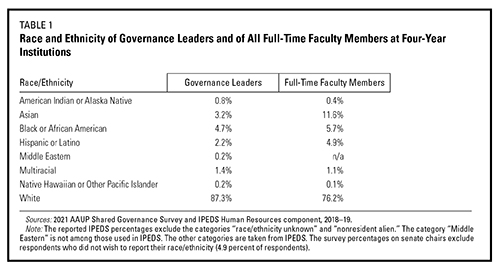
Dear Commons Community,
Hans-Joerg Tiede, the Director of Research for the AAUP, gives a report in the current issue of Academe on the 2021 AAUP Shared Governance Survey. It provides data (see sample table above) on governance leaders at four-year colleges and universities. Here is an excerpt.
“The 2021 AAUP Shared Governance Survey, the first such national survey in two decades, covered a wide range of topics related to academic governance. I reported on responses to survey questions about the impact of the COVID-19 pandemic on governance and the relative authority of the faculty in various areas of academic decision-making in an online data snapshot titled “Survey Data on the Impact of the Pandemic on Shared Governance” and in the report Findings on Faculty Roles by Decision-Making Areas, respectively. This report focuses on responses to questions about the composition of senates and similar faculty governance bodies, faculty-board communication, and the conduct of presidential searches as well as questions about the demographic composition and professional characteristics of faculty governance leaders. I present the results by institutional control (public or private nonprofit); by Carnegie classification (distinguishing broadly between doctoral, master’s, and bachelor’s institutions); by institutional size, with institutions categorized as “small” (fewer than two thousand students), “medium” (between two thousand and five thousand students), or “large” (more than five thousand students); and by the collective bargaining status of tenured and tenure-track faculty members (at institutions with a tenure system) or full-time faculty members (at institutions without a tenure system). When possible, I also compare findings with results from previous national surveys on shared governance conducted or sponsored by the AAUP…
… Findings related to the demographics of senate chairs show that, as a group, they are overwhelmingly full-time faculty members at the higher ranks and, at tenure-granting institutions, have tenure. Compared with the overall racial and ethnic composition of full-time faculty members at four-year institutions, white faculty members are overrepresented, and Asian faculty members, especially, are underrepresented among faculty governance leaders.
Interesting data on a population that has generally not been studied very much!
Tony


